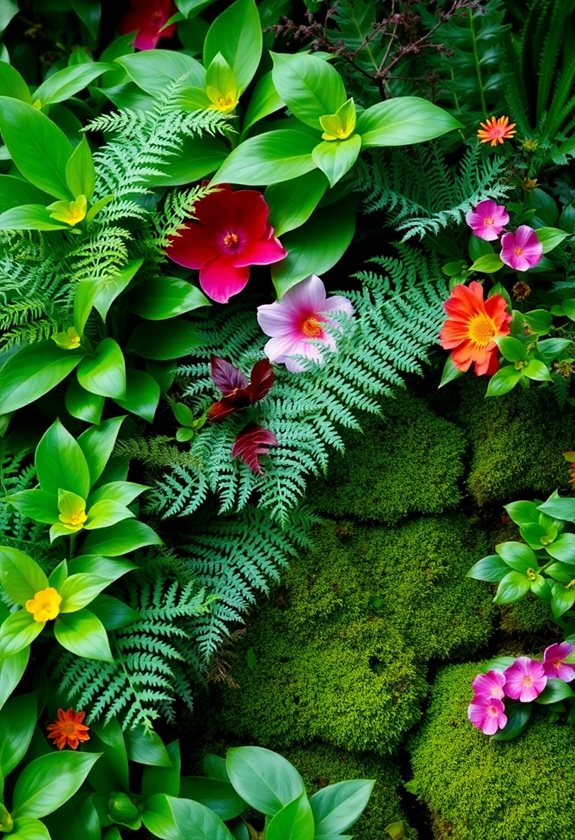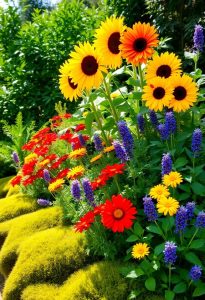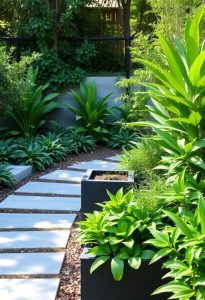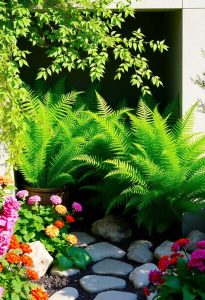Mixing textures in your garden is like giving it a personality! By combining plants with soft lamb’s ear leaves, elegant Japanese maples, and bold sedums, you create a lush feel that invites exploration. Don’t forget to vary plant heights—tall sunflowers behind, medium coneflowers in the middle, and low ground covers at the front. This layered look adds depth and intrigue. It’s all about balance! Ready for some tips to mix textures like a pro? Let’s dig in more!
Design Highlights
- Combine smooth-leaved plants like hostas with coarse textures such as grasses for striking visual contrast in your garden.
- Incorporate a variety of heights by placing tall plants at the back and low ground covers in front to create depth.
- Use plants with different textures, like velvety Lamb’s Ear and spiky succulents, to invite sensory engagement and curiosity.
- Layer colors within the same family while mixing textures to maintain visual interest and harmony in your garden design.
- Experiment with seasonal changes by including both evergreens and deciduous plants for year-round textural appeal.
Understanding the Importance of Texture in Garden Design
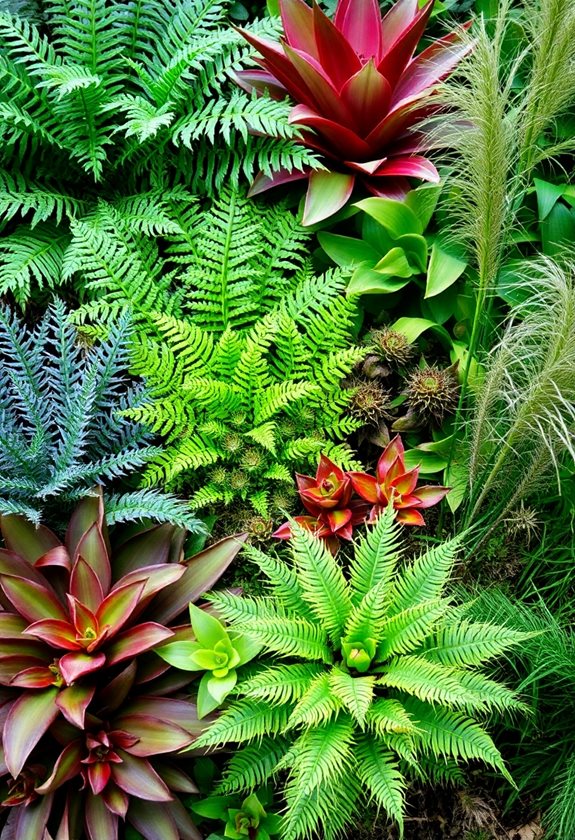
When you step into your garden, don’t you want it to feel alive and vibrant, like a secret wonderland just waiting for you to discover? Texture plays an essential role in creating that enchanting atmosphere. By mixing smooth, coarse, glossy, and fuzzy leaves, you can craft a dynamic environment that invites curiosity. Imagine contrasting a soft fern with the boldness of a spiky succulent! This interplay not only captivates the eye but also engages the senses. Experiment with layering textures; it adds depth and interest. Incorporating layering techniques can further enhance your garden’s visual appeal. So, why not jump in? Your garden’s personality awaits, ready to bloom into a masterpiece of tactile beauty!
Key Plants for Textural Contrast
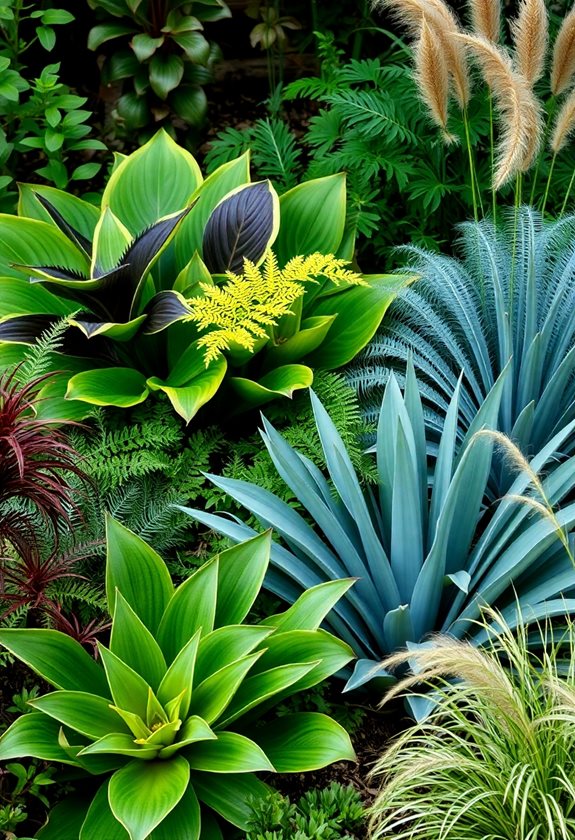
Creating a mesmerizing garden means choosing the right plants to achieve that stunning textural contrast. Think about combining the smooth leaves of hostas with the jagged edges of ornamental grasses like blue fescue. Ever tried mixing spiky succulents with fluffy ferns? It’s a game-changer!
Elevate your garden’s beauty by blending smooth hostas with jagged grasses and spiky succulents for stunning textural contrast.
Here are some key plants to contemplate:
- Lamb’s Ear for velvety softness
- Japanese Maple for elegant, lacy foliage
- Sedum for a bold, architectural presence
These contrasts not only captivate the eye but also create depth in your garden. Additionally, understanding how to mix textures effectively can significantly enhance your design. Ready to experiment? Your masterpiece awaits!
Layering Heights for Visual Interest
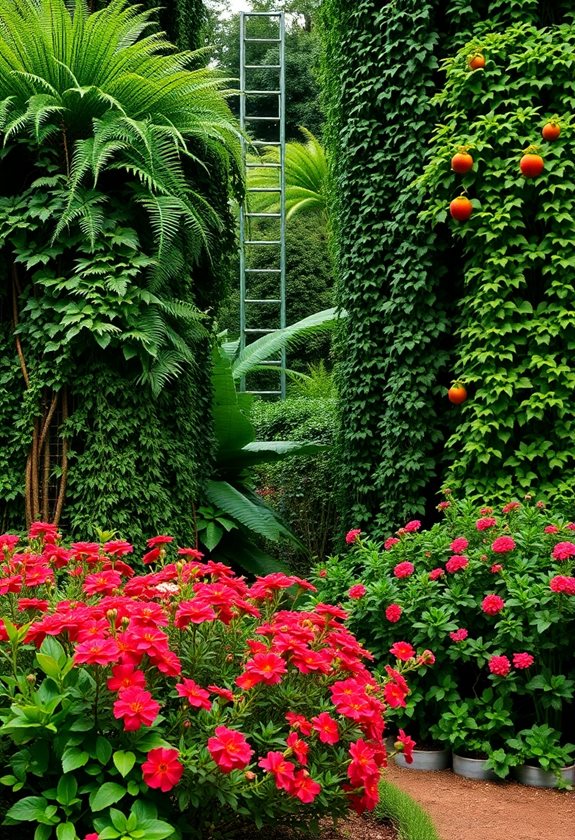
Imagine walking through a garden where each plant seems to reach out and say, “Look at me!” Layering heights is a fantastic way to achieve that enchanting effect. By varying the heights of your plants, you create a dynamic visual experience. Start with tall plants like sunflowers or delphiniums in the back, then shift to medium-sized beauties like coneflowers, and finish with low-growing ground covers. This arrangement draws the eye and encourages exploration. Have you ever noticed how a well-structured garden feels like a story unfolding? So, give your garden that narrative by mastering height variation—it’s rewarding and oh-so-inviting! Additionally, employing foliage layering techniques can further enhance the depth and richness of your garden’s aesthetic.
Color and Texture: Finding the Right Balance
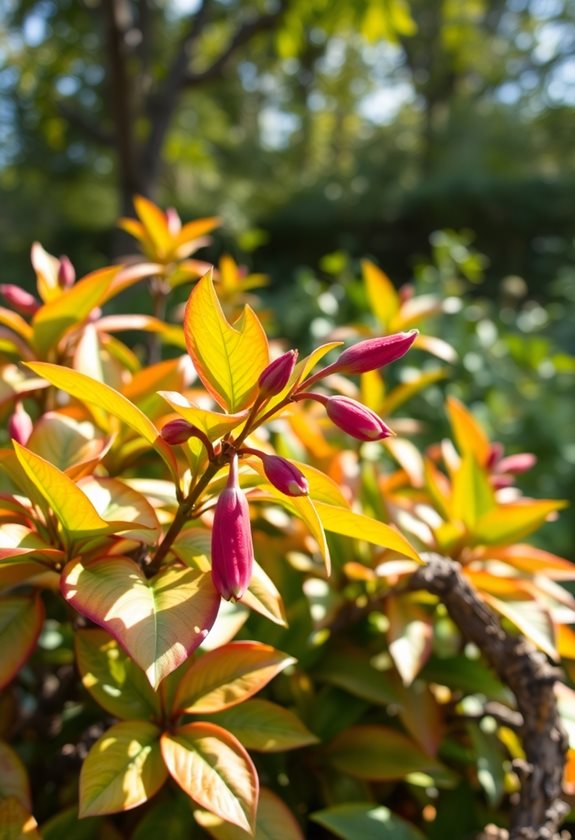
While you’re planning your garden, balancing color and texture can feel a bit like trying to find the perfect playlist for a road trip—too many slow songs, and you might nod off; too many upbeat tunes, and you could go a little wild! To create that dreamy harmony, consider these tips:
- Choose a dominant color: Pick one hue to anchor your garden’s vibe.
- Mix textures: Combine smooth leaves with coarse foliage for depth.
- Layer colors: Use varying shades within the same color family to maintain interest.
Incorporating edible plants not only adds beauty but also provides flavor to your garden, enhancing your overall experience. Finding the right balance transforms your space from ordinary to extraordinary! Isn’t that exciting?
Seasonal Textures: Planning for Year-Round Appeal
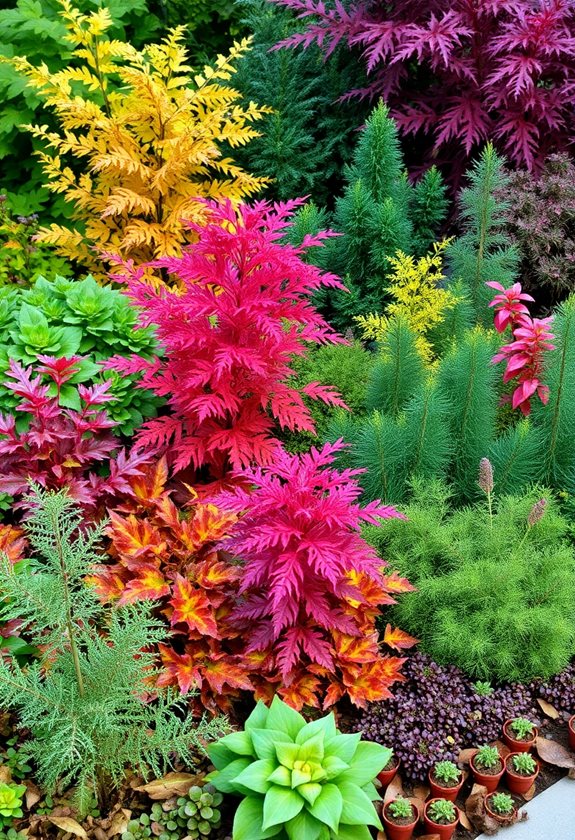
When you think about your garden, don’t you want it to shine in every season? Embracing seasonal textures creates a breathtaking landscape year-round. Imagine lush ferns in spring, vibrant annuals in summer, striking ornamental grasses in fall, and delicate evergreens in winter. Each season brings a unique charm, so plan your plant choices wisely!
Embrace seasonal textures for a garden that dazzles year-round with unique charm in every season.
Consider:
- Spring: Plant early bloomers like hellebores.
- Summer: Add bold hostas for rich foliage.
- Fall: Incorporate colorful sedums.
- Winter: Use evergreen shrubs for structure.
Mixing these textures will keep your garden lively, inviting, and full of surprises! Plus, who doesn’t love a garden that’s always ready for a photo op? Adding lush garden ideas tailored for small spaces will further enhance your garden’s appeal throughout the year!
Practical Tips for Mixing Textures Effectively
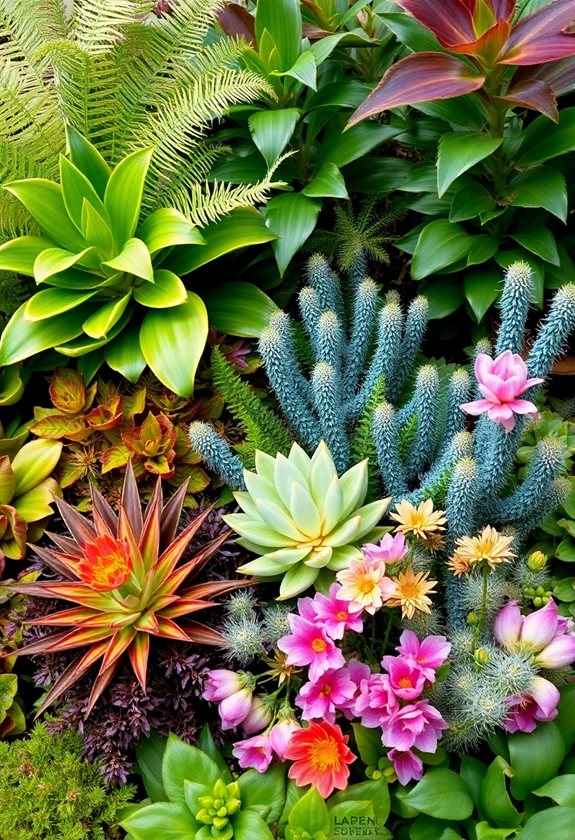
Mixing textures in your garden can seem intimidating, but it doesn’t have to be! With a bit of planning, you can create a lush, inviting space. Here are three practical tips to get you started:
- Choose a variety of foliage: Combine broad leaves with fine-textured plants, like hostas and ferns.
- Vary heights and shapes: Layer plants to create visual interest; tall grasses can accentuate low blooms.
- Incorporate seasonal changes: Mix evergreens with deciduous plants for year-round appeal. Additionally, understanding layering plants can enhance the structure and depth of your landscape.
Don’t forget to have fun experimenting! What textures catch your eye? Let your garden reflect your unique style!
Frequently Asked Questions
How Do I Choose the Right Soil for Different Textures?
Choosing the right soil feels like picking the perfect paint for a masterpiece! You want a mix that suits your plants’ needs. For heavier textures, go for loamy soil, which retains moisture. Sandy soil’s great for drainage, perfect for succulents. Don’t forget to test pH! You can use soil test kits to guarantee your garden thrives. So, what’s your garden’s personality? With the right soil, your plants will sing! 🌱
Can I Mix Textures in Pots or Containers?
Absolutely, you can mix textures in pots or containers! It’s like creating a mini garden masterpiece. Think about combining smooth-leaved plants with those that have feathery or spiky foliage. For example, pairing a glossy-leafed plant with a fuzzy one adds visual interest. Just make certain they have similar light and water needs. Have fun experimenting! Who knows? You might stumble upon a combination that makes your heart sing! What will you create next?
What Maintenance Do Textured Plants Require?
Think of textured plants like a diverse team in a sports game; they each have unique strengths! To keep them thriving, you’ll need regular watering, especially in dry spells. Pruning helps shape them, while checking for pests keeps their spirits high. Don’t forget to feed them with the right fertilizer! It’s a bit of a juggling act, but with a little love and attention, they’ll flourish beautifully. What’s your favorite plant to maintain?
Are There Any Plants That Should Not Be Mixed?
When mixing plants, you’ll want to avoid certain combinations. For instance, don’t pair aggressive growers like mint with delicate plants, or you might end up with a garden takeover! Also, steer clear of mixing plants with vastly different water needs, like succulents and ferns. They’ll both suffer! Keep in mind that some plants can bring out the best in each other, while others can create chaos—so choose wisely! Isn’t gardening a fun puzzle?
How Do Weather Conditions Affect Texture in Gardens?
Weather conditions can dramatically affect your garden’s texture! Think about it: intense heat can cause plants to wilt, while heavy rain might leave them soggy and droopy. You’ll want to observe how different plants react. For instance, succulents thrive in dry, sunny spots, while ferns prefer cooler, shadier areas. Have you noticed how a sunny day can really perk up those leaves? Keep experimenting, and your garden’s texture will flourish!

